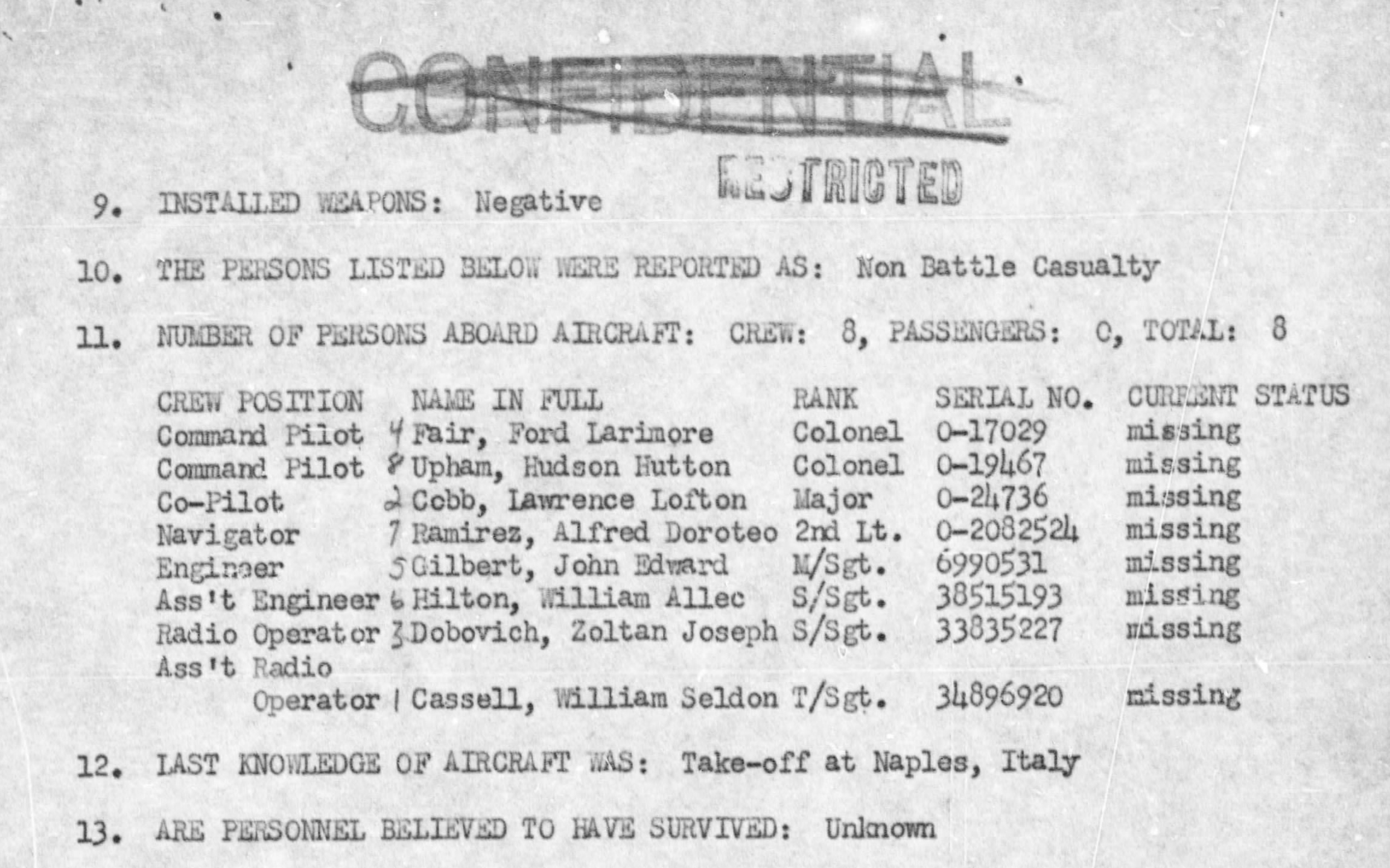Un aereo B-17G assegnato all’European Air Transport Service (EATS) dell’esercito statunitense, con un equipaggio di 4 ufficiali e 4 sottufficiali, partì dalla Base Aerea di Capodichino (Napoli, Italia) intorno alle 2:00 del mattino del 1° novembre 1946. La sua destinazione era Bovingdon, un aeroporto vicino a Southampton, in Inghilterra.
Il Piano di Volo prevedeva che l’aereo seguisse una rotta parallela alla costa italiana fino all’isola di Gorgona (tra la punta della Corsica e Pisa), quindi effettuasse una virata di 45 gradi a sinistra verso Istres (Marsiglia), da dove si sarebbe diretto a nord via Lione e Parigi, per poi attraversare il Canale della Manica fino a Bovingdon.
Il Piano di Volo identificava vari aeroporti alternativi nel caso in cui le condizioni meteorologiche avessero impedito la prosecuzione del volo in qualsiasi punto. Nonostante l’attenta pianificazione, l’aereo era destinato a non effettuare mai un atterraggio sicuro in nessuno di essi.
Erano state previste condizioni meteorologiche avverse con forti temporali nella prima tratta della rotta (fino a Istres), ma il comandante dell’aereo, il Colonnello Hudson H. Upham, dopo aver discusso a lungo la situazione con gli esperti meteorologici di Capodichino, con il suo collega Pilota Comandante Colonnello Ford L. Fair e con il suo Co-pilota, il Maggiore Lawrence L. Cobb Jr., esaminò una serie di possibili rotte, concordò il Piano di Volo e autorizzò la partenza dell’aereo.
Un messaggio radio di routine fu trasmesso pochi minuti dopo il decollo, dopodiché non furono più ricevuti altri messaggi.
Quando l’aereo non arrivò in Inghilterra, furono fatte richieste di informazioni sugli ausili alla navigazione locali, ma senza alcun segno dell’aereo presso nessuna stazione conosciuta, incluso l’aerodromo di Orly a Parigi (la sua destinazione alternativa), fu emesso un Rapporto di Aereo Disperso (consulta Rif. A). Una serie di telegrammi furono quindi inviati alle varie stazioni lungo la rotta pianificata per chiedere notizie dell’aereo, ma tutte le risposte furono “nessuna notizia”. Il Quartier Generale EATS emise quindi una serie di messaggi di “Avvio Ricerca” a Capodichino, Istres e Orly, identificando le aree di ricerca da coprire (consulta Rif. B). Fu avviata una copertura completa dell’intera rotta per una profondità di 60 miglia su entrambi i lati della traiettoria prevista.
Il 6 novembre 1946, dopo aver ricevuto un rapporto iniziale (consulta Rif. D) dal Cap. Steigner, l’Ufficiale Meteorologico di Capodichino, il Generale di Brigata Lucas Beau dell’EATS scrisse una lettera (consulta Rif. C) al Maggiore Generale Edwards, Comandante Generale delle Forze Aeree degli Stati Uniti in Europa. Pur esprimendo la sua convinzione che l’equipaggio di volo del B-17 fosse molto esperto e altamente capace, affermò anche: “Pensare che questi ufficiali esperti avrebbero dato il via libera dopo essere stati informati dall’ufficiale meteorologico della stazione e dal previsore riguardo al ghiaccio e ai forti temporali lungo la loro rotta, è oltre la mia comprensione.”

Il 7 novembre 1946, fu emesso un Rapporto sull’Equipaggio Aereo Disperso (consulta Rif. E). Questo identificava i seguenti otto membri dell’equipaggio come “vittime non in combattimento”:
- Colonnello Ford L. Fair (Pilota Comandante)
- Colonnello Hudson H. Upham (Pilota Comandante)
- Maggiore Lawrence L. Cobb (Co-pilota)
- 2° Tenente Alfred D. Ramirez (Navigatore)
- M/Sgt John E. Gilbert (Ingegnere)
- S/Sgt William A. Hilton (Assistente Ingegnere)
- S/Sgt Zoltan J. Dobovich (Operatore Radio)
- T/Sgt William S. Cassell (Assistente Operatore Radio).
Il 18 novembre 1946, nonostante quasi 3 settimane di intensa attività di ricerca che coinvolse più di 50 aerei americani, francesi, britannici e svizzeri, nulla era stato trovato e il Generale Beau autorizzò l’abbandono della ricerca formale (consulta Rif. F). L’affermazione che “ci si aspettava l’adesione al Piano di Volo presentato prima della partenza” per gli altri aerei sembra suggerire che l’EATS fosse convinto che il B-17 disperso fosse fuori dalla rotta identificata nel suo piano di volo (consulta Rif. G). Sebbene la ricerca formale fosse stata sospesa, a tutti i voli di routine lungo la rotta in cui si riteneva che l’aereo avesse volato fu consigliato di prestare attenzione a qualsiasi segno del suo relitto.
Il 30 novembre, il Cap. Steigner, l’Ufficiale Meteorologico di Capodichino, fornì una descrizione più dettagliata di quanto accaduto durante il briefing meteorologico a Fair, Upham e Cobb (consulta Rif. H).
Il 2 dicembre, il Generale di Brigata Lucas Beau dell’EATS notificò formalmente sia il Generale Edwards che il Capo dei Servizi di Sicurezza del Volo a Langley Field, in Virginia, i dettagli essenziali della ricerca e incluse copie della documentazione ufficiale relativa al “Rapporto sull’Aereo Disperso” in corso (consulta Rif. I).
File di riferimento
Allegati:
- Rif A Trascrizione del Telegramma del Rapporto di Incidente del 2 novembre
- Rif B Telegrammi di Avvio Ricerca
- Rif C Lettera dal Generale Beau al Generale Edwards
- Rif D Dichiarazione di Capodichino relativa al volo
- Rif E Rapporto Aereo Disperso
- Rif F Istruzione per l’abbandono della ricerca
- Rif G1 Piano di Volo
- Rif G2 Rotta del Piano di Volo
- Rif H Condizioni meteorologiche al momento del volo – deposizione del 30 novembre 1946
- Rif I Lettera dal Generale Beau al Generale Edwards

